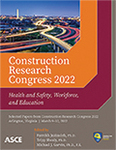Review for Construction and Demolition Waste Materials and Control Practices in the US
Publication: Construction Research Congress 2022
ABSTRACT
Construction and demolition (C&D) waste is generated from the various construction activities. The disposal of C&D waste materials in landfills can adversely affect the environment and human health and is not viable economically. Also, C&D waste materials left on construction sites can threaten the safety of construction workers. The application of strategic C&D waste management practices is essential for sustainable management of limited resources and thereby can benefit the environment, economy, and public safety. The objective of this paper was to explore various waste management practices to control C&D waste and the current status of C&D waste management in the United States (US) through a literature review. As a result, this paper presented clear descriptions of the C&D waste management practices in the EPA waste management hierarchy, employing a few examples. The 2018 C&D waste data from the US Environmental Protection Agency (EPA) were utilized to understand the current status of the C&D waste management in the US. The C&D waste management practices feasible for a few sluggish materials for next-use were presented to raise the recovery rate of C&D waste in the US. The findings of this study can be summarized as follows: (1) the C&D waste recovery rate in the US was below the average of some developed countries; (2) the recovery rates of some waste materials negatively affected the overall C&D waste recovery rate; and (3) the C&D waste management needs more strategic commitment to the upper-level practices in the waste management hierarchy.
Get full access to this article
View all available purchase options and get full access to this chapter.
REFERENCES
Bolden, J., Abu-Lebdeh, T., and Fini, E. (2013). “Utilization of recycled and waste materials in various construction applications.” American J. of Environmental Science, 9(1), 14–24.
Bossink, B. A. G., and Brouwers, H. J. H. (1996). “Construction waste: quantification and source evaluation.” J. Constr. Engrg. and Mgmt., 122(1), 55–60.
Chen, G. H. (2012). “Thoughts on short lived architecture in China.” Journal of Shenzhen Polytechnic, 01, 67–72.
Craven, D. J., Okraglik, H. M., and Eilenberg, I. M. (1994). “Construction waste and a new design methodology.” Proc., First Conf. of CIB TG 16 on Sustainable Construction. Center for Construction and Environment, Gainesville, FL, 89–98.
Duan, H., Miller, T. R., Liu, G., and Tam, V. W. (2019). “Construction debris becomes growing concern of growing cities.” Waste Management, 83, 1–5.
EPA. (2017). “Sustainable materials management: Non-hzardous materials and waste management hierarchy.” EPA, <https://www.epa.gov/smm/sustainable-materials-management-non-hazardous-materials-and-waste-management-hierarchy>(June 7, 2021).
EPA. (2020a). “Advancing sustainable materials management: 2018 fact sheet. Assessing trends in materials generation and management in the United States. EPA, <https://www.epa.gov/sites/production/files/2021-01/documents/2018_ff_fact_sheet_dec_2020_fnl_508.pdf> (April 14, 2021).
EPA. (2020b). “Construction and demolition debris: materials-specific data.” EPA, <https://www.epa.gov/facts-and-figures-about-materials-waste-and-recycling/construction-and-demolition-debris-material> (April 19, 2021).
EPA. (2020c). “Construction and demolition debris management in the United States, 2015.” EPA, <https://www.epa.gov/sites/production/files/2020-03/documents/final_cd-eol-management_2015_508.pdf≥ (June 10, 2021).
EPA. (2021a). “Advancing sustainable materials management: facts and figures report.” EPA, < https://www.epa.gov/facts-and-figures-about-materials-waste-and-recycling/advancing-sustainable-materials-management> (June 10, 2021).
EPA. (2021b). “Sustainable management of construction and demolition materials.” EPA, <https://www.epa.gov/smm/sustainable-management-construction-and-demolition-materials#America > (June 10, 2021).
Franklin Associates. (1998). Characterization of building-related construction and demolition debris in the United States. EPA530-R-98-010. EPA, Washington, DC.
Gavilan, R. M., and Bemold, L. E. (1994). “Source evaluation of solid waste in building construction.” J. Constr. Engrg. and Mgmt., 120(3). 536–555.
ICF. (2020). “Documentation for greenhouse gas emission and energy factors used in the Waste Reduction Model (WARM).” EPA, <https://www.epa.gov/sites/production/files/2020-12/documents/warm_construction_materials_v15_10-29-2020.pdf>(June 10, 2021).
Huang, B., Wang, X., Kua, H., Geng, Y., Bleischwitz, R., and Ren, J. (2018). “Construction and demolition waste management in China through the 3R principle.” Resources, Conservation and Recycling, 129, 36–44.
Marzouk, M., and Azab, S. (2014). “Environmental and economic impact assessment of construction and demolition waste disposal using system dynamics.” Resources, Conservation and Recycling, 82, 41–49.
Napier, T. (2016). “Construction waste management.” Whole Building Design Guide. <https://www.wbdg.org/resources/construction-waste-management> (April 20, 2021).
Ortiz, O., Pasqualino, J. C., and Castells, F. (2010). “Environmental performance of construction waste: Comparing three scenarios from a case study in Catalonia, Spain.” Waste Management, 30(4), 646–654.
Shooshtarian, S., Maqsood, T., Wong, P., Khalfan, M., and Yang, R. (2019). “Review of energy recovery from construction and demolition waste in Australia.” J. Constr. Eng. Manag. Innov., 2, 112–130.
Taghipour, H., Taghizadeh Jazadani, R., Dehghanzadeh, R., Asghari Jafarabadi, M., Mir Mohammadi, M., and Ghayebzadeh, M. (2019). “Construction and demolition waste and its management challenges in Iran: A case study in Tabriz city.” Health Scope, 8(2):e62313, https://doi.org/10.5812/jhealthscope.62313.
Townsend, T., and Anshassi, M. (2017). “Benefits of construction and demolition debris recycling in the United States.” Construction and Demolition Recycling Association, <https://cdrecycling.org/site/assets/files/1050/cdra_benefits_of_cd_recycling_final_revised_2017.pdf> (April 20, 2021).
Yan, M. C. (2001). Introduction to new ecological economics. Chinese Zhigong Press, Beijing.
Yang, K., Xu, Q., Townsend, T. G., Chadik, P., Bitton, G., and Booth, M. (2006). “Hydrogen sulfide generation in simulated construction and demolition debris landfills: Impact of waste composition.” Journal of the Air & Waste Management Association, 56(8), 1130–1138.
Yeheyis, M., Hewage, K., Alam, M. S., Eskicioglu, C., and Sadiq, R. (2013). “An overview of construction and demolition waste management in Canada: a lifecycle analysis approach to sustainability.” Clean Technologies and Environmental Policy, 15(1), 81–91.
Yu, A. T., Wong, I., Wu, Z., and Poon, C. S. (2021). “Strategies for effective waste reduction and management of building construction projects in highly urbanized cities – a case study of Hong Kong. Buildings, 11(5), 214.
Yuan, F., Shen, L. Y., and Li, Q. M. (2011). “Emergy analysis of the recycling options for construction and demolition waste.” Waste Management, 31(12), 2503–2511.
Information & Authors
Information
Published In
History
Published online: Mar 7, 2022
Authors
Metrics & Citations
Metrics
Citations
Download citation
If you have the appropriate software installed, you can download article citation data to the citation manager of your choice. Simply select your manager software from the list below and click Download.
